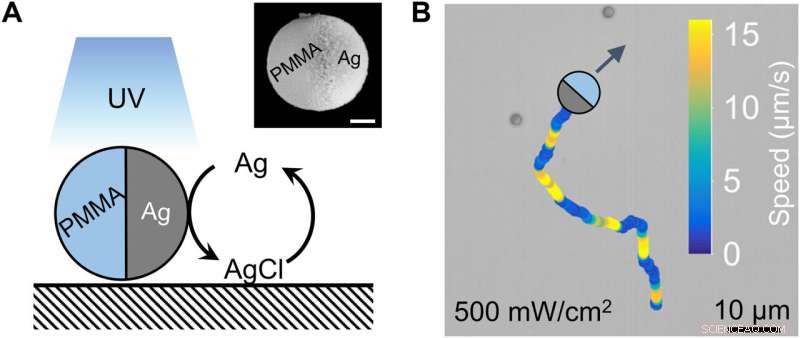
Oscillerande kolloider. (A) En mikrosfär av polymetylmetakrylat (PMMA) halvbelagd med silver (Ag) genomgår en oscillerande kemisk reaktion mellan Ag och AgCl i närvaro av UV-ljus, H2O2 och KCl (ej visat). Infälld:svepelektronmikrofotografi av PMMA-Ag Janus-sfären; skalstång, 0,5 μm. (B) En representativ bana för en PMMA-Ag Janus-kolloid som pendlar mellan episoder av snabb och långsam rörelse. Dess momentana hastigheter är färgkodade. Kredit:Science Advances (2022). DOI:10.1126/sciadv.abn9130
Vandringsvågor observeras vanligtvis i biologiska och syntetiska system, och nya upptäckter har visat hur silverkolloider bildar resande rörelsevågor i väteperoxid under UV-ljus. I en ny rapport som nu publicerats i Science Advances , Xi Chen och ett team av forskare inom smarta material, fysik och optik vid Harbin Institute of Technology och Shanghai Jiao Tang University, i Kina, visade den kolloidala rörelsevågen som ett heterogent exciterbart system.
Silverkolloiderna genererade resande kemiska vågor via reaktionsdiffusion och var antingen självgående eller advektionerade via diffusion eller osmos. Teamet observerade de grundläggande resultaten med hydroxid- och pH-känsliga färgämnen och använde en Rogers-McCulloch-modell för att kvantitativt och kvalitativt producera de karakteristiska egenskaperna hos kolloidala vågor. Resultaten banar väg för att integrera kolloidala vågor som en plattform för att studera icke-linjära fenomen, och undersöka kolloidal transport för att utforska informationsöverföring i biomimetiska mikrorobotensembler.
Översätta biologiska svängningar i labbet
Oscillerande processer observeras allmänt i levande system, varierande från dygnsrytmen till cytosoliska oscillationer. Kopplingen mellan oscillerande enheter kan leda till synkronisering som ger upphov till vandringsvågor, vilket observeras med kalciumvågor som sprider sig över ett befruktat ägg, aktionspotentialer som sprider sig över hjärtceller som slår, mitotiska tillstånd och vågor av självorganiserande amöbor. Biofysiker strävar efter att förstå den fysikalisk-kemiska naturen hos dessa vågor för att undersöka de underliggande trenderna i livet. Nya upptäckter av de fotokemiskt aktiva, silverhaltiga oscillerande kolloiderna är ett spännande tillägg till familjen av olinjära processer.
När forskare nedsänkte en inert polymermikrosfär halvbelagd med silver i en vattenlösning av väteperoxid eller kaliumklorid och exponerade dem för ljuskällor, noterade de visningen av pulser. De föreslog att silvernanopartiklarna som producerades under experimentet fungerade som katalytiska hotspots för att möjliggöra ytterligare reaktioner. Oavsett den kemiska detaljen noterade teamet hur diffusion av kemikalier drev Janus-partiklarna via självdiffusiofores, för att ge upphov till liknande kolloidal rörelse. I detta arbete erbjöd Chen et al en första syn på att generera de kemiskt aktiva kolloiderna och övervakade deras svar på kemiska vågor bortom de klassiska reaktionsdiffusionssystemen. Resultaten erbjuder starka möjligheter för translationell forskning som kopplar aktiv materia till icke-linjär vetenskap för att reglera svärmar av biomimetiska mikroskopiska maskiner.
Teamet noterade utvecklingen av periodiska kolloidala rörelsevågor i synkroniserad fortplantning. De hade tidigare registrerat ballistiska vågor med en mellanliggande befolkningstäthet, där aktiverade kolloider vid vågfronten rörde sig i alla riktningar på grund av foretisk självframdrivning. Forskarna noterade uppkomsten av kvalitativt olika typer av vågor, kända som svärmande vågor vid ännu högre befolkningstätheter. I det här fallet utvecklade teamet polymetylmetakrylat-mikrosfärer halvbelagda med silver (PMMA-Ag), suspenderade i väteperoxid och kaliumklorid och belysta med 365 nm ljus. Den kolloidala partikeln som innehåller silver skulle i princip kunna avge svärmande vågor. De experimentella resultaten indikerade ett resultat som liknar den "mexikanska vågen" som ses på fotbollsarenor. Teamet kvantifierade sedan den svärmande vågen via spårning av en partikel och mikropartikelbildhastighet genom att betrakta de kolloidala partiklarna som flödesspårare. I detta fall färdades vågen med en hastighet av 16 µm/s, med inställbara parametrar. Förändringar i ljusintensiteten förändrade endast lindrigt perioden och hastigheterna för en svärmande våg. The team distinguished the swarming waves from ballistic waves via their characteristic mobility and physicochemistry
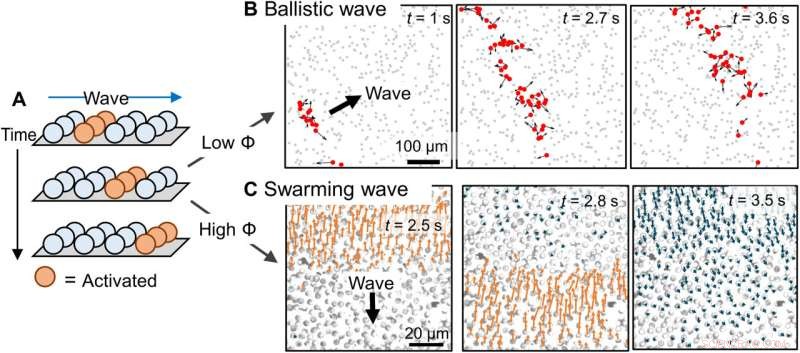
Ballistic and swarming colloidal waves. (A) Schematic diagram of a colloidal motion wave propagating to the right. Each sphere is half-coated with Ag that is not drawn. (B) Ballistic wave propagating across a population of PMMA-Ag colloids. Activated colloids are marked with red dots and their velocities are labeled with arrows. ϕ =1.3%. This figure came from figure 1D in (27). Copyright 2021, Royal Society of Chemistry. (C) Swarming wave propagating downward. Particle velocities are labeled with arrows, so that those moving toward an incoming wave are in orange and those trailing a wave are in dark blue. ϕ =29%. Kredit:Science Advances (2022). DOI:10.1126/sciadv.abn9130
Chemical waves:The physicochemical nature of a colloidal wave
Chen et al described the physicochemical nature of the activation and recovery of colloidal waves. Since the wave phenomenon is inspired by traveling waves in reaction-diffusion systems, they hypothesized colloidal waves to be underpinned by a traveling chemical wave, due to reaction-diffusion mechanisms. For instance, hydrogen peroxide can decompose faster in higher pH to form a burst of highly oxidative intermediates that oxidized silver into silver chloride. The resulting chemical reactivity activated the silver-colloid to release a burst of chemicals to maintain chemical wave propagation. They confirmed the production of hydroxide anions during silver oxidation, and the formation of hydrogen cations during silver chloride photodecomposition, at and behind the chemical wavefront by using fluorescence mapping and pH measurements.
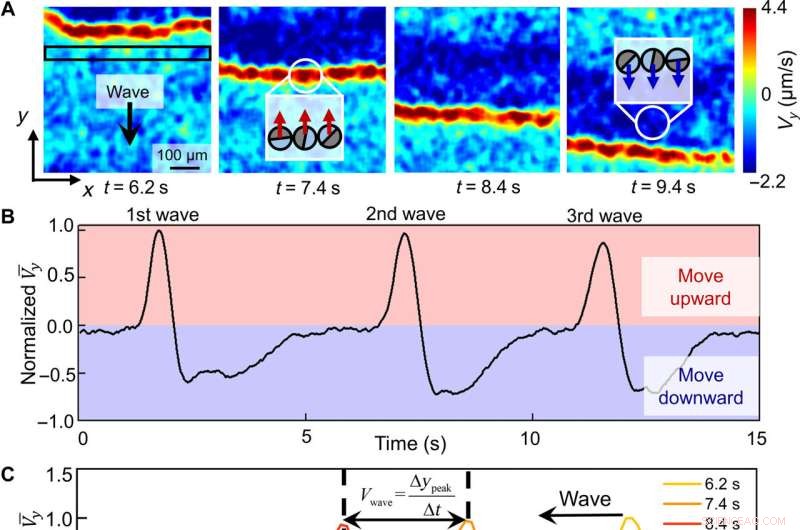
Quantitative characterization of a swarming wave. (A) Micro-PIV–generated flow velocities along the y direction (Vy) of a population of PMMA-Ag particles during the downward propagation of a wave. Positive (upward) velocities are colored red and negative velocities are colored blue. Cartoons in the insets represent how colloids move at or after a wavefront. (B) Normalized Vy averaged across the rectangular box labeled in (A) during the downward propagation of three consecutive waves. Wave periods are calculated by finding the time differences between the peaks. (C) Normalized flow velocities averaged over x at four different time instances labeled in (A) as one wave propagates along y. Wave speed, Vwave, is calculated by dividing the distance the wavefront travels along y (∆ypeak) by the time interval ∆t. (D) Wave periods and speeds under different light intensities. (E) Wave speeds at different population densities ϕ. (F) Particle speeds at different population densities. Error bars represent SDs from three measurements; 0.5 wt % H2O2 and 200 μM KCl were used in all experiments in this figure. Kredit:Science Advances (2022). DOI:10.1126/sciadv.abn9130
Colloids respond to a chemical wave:Modeling a reaction-diffusion colloidal wave
The scientists next studied the dynamics of colloidal particles in a chemical wave to dictate the type of colloidal wave formed. They noted ionic self-diffusiophoresis, and at higher ionic densities they noted weaker electro-kinetic effects for reduced self-propulsion. They identified the dynamics of neutral diffusio-osmosis dynamics, which moved colloid particles via advection, in addition to self-propagation. As self-propagation weakened and diffusio-osmosis intensified in a crowded solution with rising ionic strength, the colloidal wave switched to swarming wave. The team observed a range of effects, including electrokinetic effects, advection support via osmosis, and self-propulsion during the experiments. Chen et al next reproduced and corroborated the proposed reaction-diffusion colloidal wave via numerical simulations. At the first step, they used the Rogers-McCulloch model to simulate a chemical wave, the resulting numerical models qualitatively reproduced key features, to explore the dynamics of colloidal waves.
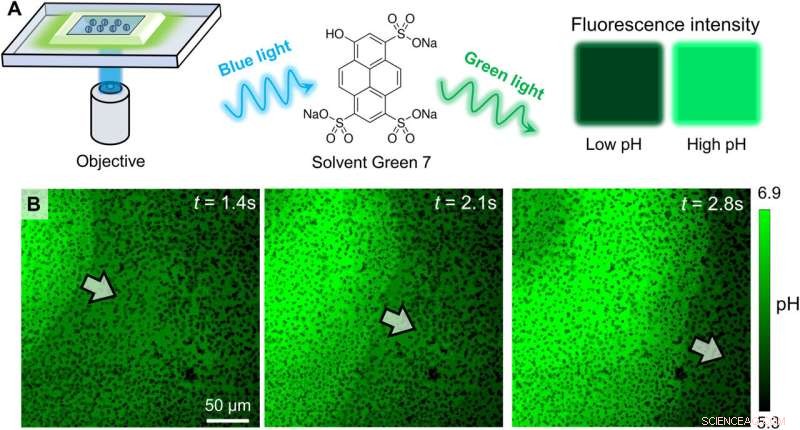
Experimental confirmation of an OH− wave. (A) Schematic diagram of the experimental setup for relating the fluorescence emission of Solvent Green 7 with local pH. (B) Optical micrographs of the pH profile during the propagation of a colloidal wave. PMMA-Ag particles of a population density ϕ of 25% were suspended in an aqueous solution containing 0.5 wt % H2O2, 200 μM KCl, and 100 μM Solvent Green 7. A blue light source (475 nm, 75 mW/cm2) served both to activate the oscillatory reaction and to excite the dye molecules. Kredit:Science Advances (2022). DOI:10.1126/sciadv.abn9130
Qualitative comparison of colloidal waves between experiments (left) and simulations (right). (A to D) Evolution of target waves (A and B) and spiral waves (C and D). (E and F) The annihilation of two colloidal waves traveling in opposite directions. (G and H) Two consecutive waves. In all experiments, PMMA-Ag particles [population density ϕ of 20% for (B), 15% for (D), 20% for (F), and 23% for (H)] were suspended in an aqueous solution containing 0.5 wt % H2O2 and 200 μM KCl under a 405-nm illumination of 1.6 W/cm2. Kredit:Science Advances (2022). DOI:10.1126/sciadv.abn9130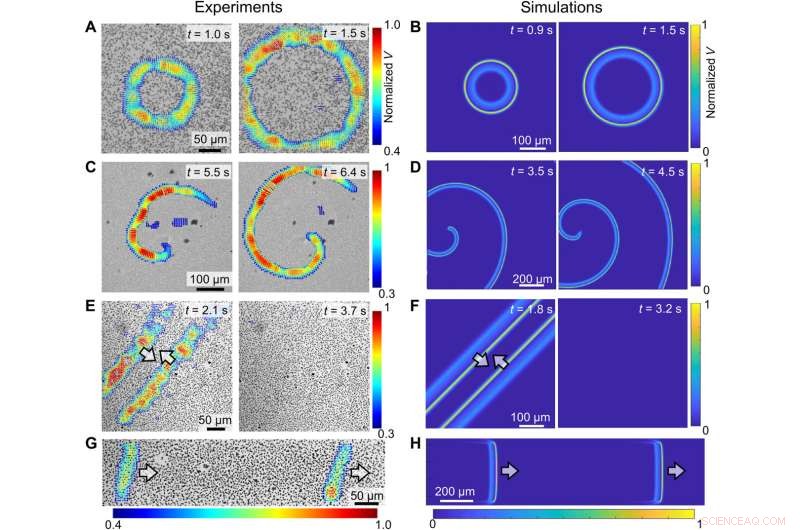
In this way, Xi Chen and colleagues developed a numerical model to simulate colloidal waves to study the heterogeneity of chemical waves. The outcomes showed good agreement with simulations and experiments to provide key insights to understand microscopic details of chemical waves in experimental systems. Colloidal waves can be integrated with optical tweezers, acoustofluidics or microfluidics to regulate micro- and nanoscopic objects in space and time. The method is useful to swarm physicochemical dynamics of a colloidal wave and can lead to develop wave-mediated information transmission systems to examine autonomous micro-robots. The colloidal waves present a good model system of reaction-diffusion processes at mesoscopic and microscopic scales. + Utforska vidare
© 2022 Science X Network